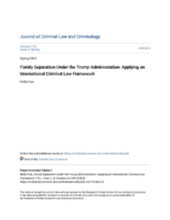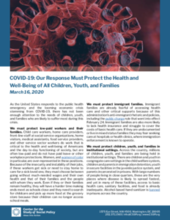Displaying 771 - 780 of 2215
These additional considerations are intended to provide guidance for a range of child care programs that remain open, and should be used in conjunction with CDC’s guidance for administrators of child care programs and K-12 schools.
This resource from Save the Children US features tools and tips for parents, caregivers, teachers and all those who care about children in crisis.
This resource from the U.S. National Child Traumatic Stress Network will help you think about how an infectious disease outbreak might affect your family—both physically and emotionally—and what you can do to help your family cope.
This Comment will propose a theoretical international criminal law response to the family separation that occurred in summer 2018.
This webpage from Be Strong Families features resources for families during the COVID-19 crisis.
In this statement on the COVID-19 pandemic, the U.S. Center for the Study of Social Policy calls for more support for those who are likely to be hurt most by the current crisis, particularly low-income families.
This free collection of articles includes relevant psychological research published across the APA Journals portfolio that are relevant to the topic COVID-19.
This statement from Jack P. Shonkoff of the Center on the Developing Child at Harvard University notes that the Center is "assembling easily accessible and actionable scientific knowledge for supporting the developmental needs of young children and their families in this current context."
This resource offers information on supporting and protecting children’s emotional well-being as this public health crisis unfolds.
This book brings together knowledge of how modern countries in Europe and the United States deal with the issue of errors and mistakes in child protection in a cross-national perspective.



